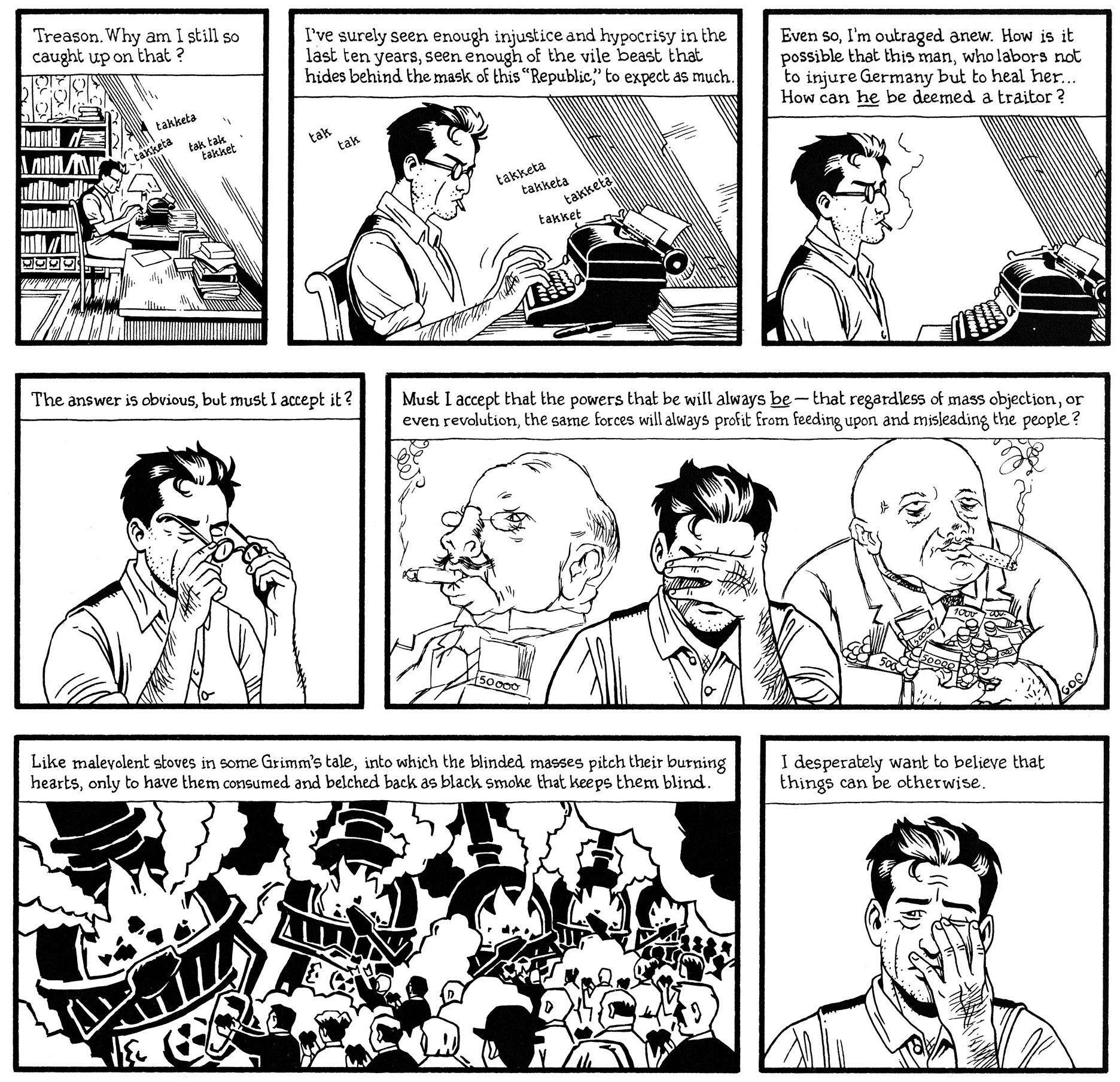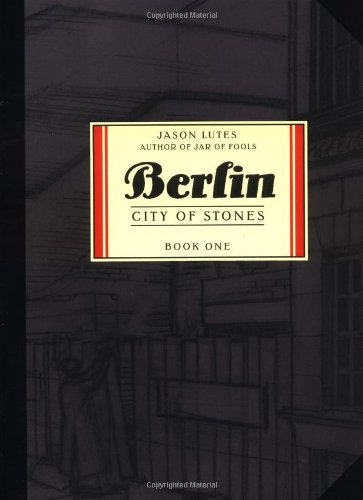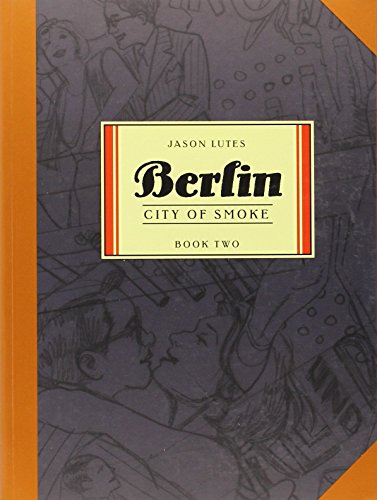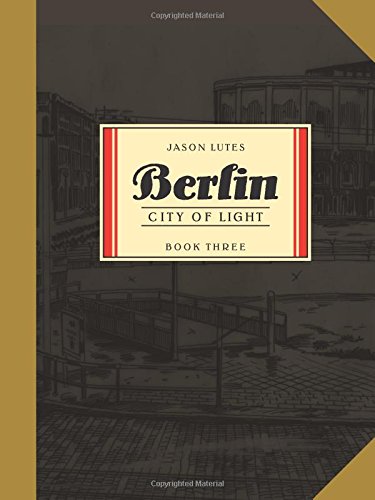Jason Lutes, Berlin: City of Stones. Book One (Drawn & Quarterly 2001)
Jason Lutes, Berlin: City of Smoke. Book Two (Drawn & Quarterly 2008)
Jason Lutes, Berlin: City of Light. Book Three (Drawn & Quarterly 2018)
This work of fiction, whose story covers the half dozen years in Berlin leading up to Hitler’s coming to power, was originally created as a series of 22 comics published over more than two decades. I read it in a single day, when I was too sick to do much else.
The first issue was published in April 1996 and the last in 2018. Those years saw 9/11, the invasion of Afghanistan, the War in Iraq and the rise of IS; Donald Trump became President of the United States, and Jason Lutes became a father (his acknowledgements in Book Three describe two people with his surname as ‘the best reasons possible to miss deadlines’). No doubt the course of the narrative departed hugely from the original plan, but there’s an awe-inspiring visual consistency – neat ink drawings in regular panels, with meticulous hatching and loving attention to architectural detail.
At the beginning of the first book Marthe Müller, an art student, meets journalist Kurt Severing on a train travelling to Berlin in September 1928. They go their separate ways at first, she to the rigours of art school (in which the reader attends a lesson in perspective, which incidentally directs our attention to the quality of much of the book’s art) and the joys of bohemia, he to his politically engaged journalism. But theirs becomes the central relationship of the story, soon featuring lots of tactfully drawn sex. The second main narrative thread involves a working-class family that splits along political lines – the father and son join the Nazis while the mother, Gudrun, is drawn to the Communists along with her two daughters. These stories play out against the backdrop of serious political tensions, with flashbacks to the founding of the Weimar Republic after World War One. The final pages of this book feature the massacre of May Day marchers in 1929, where Gudrun is among the many killed.
City of Smoke picks up the story a month later. Marthe is drawn into the famous Weimar decadence, with an Eyes Wide Shut style orgy, lots of drugs and a relationship with a gender-fluid fellow student Anna. Kurt becomes increasingly despondent at the evident futility of his journalism, as his editor is charged with treason for a significant piece of investigative journalism (a page at the end of Book Three notes that this arrest and imprisonment are historical facts).

Meanwhile, Gudrun’s daughter Silvia lives by her wits, hating the Nazis but blaming the Communists for her mother’s death. She becomes involved with a Jewish scrounger and lives for a time with a comfortable Jewish family. A third major plot line involves an African-American jazz group, and the relationship one of them forms with a cabaret performer (who also happens to be a life model at the art school in City of Stones). Again, these personal dramas play out as part of the sweep of history, as anti-Semitic violence increases, and the Nazis become a greater force. Book Two ends with the jazzmen flying out of Germany just before the September 1930 election, which increased the Reichstag seats held by Nazis from 12 to 107.
City of Light dispenses with the methodical noting of dates that has been a hallmark of the books so far. It also has slightly larger frames, slightly larger lettering, perhaps a result of Jason Lutes’ ageing eyes, and certainly a kindness to mine.
Like the first two books, this one opens with passengers on a train bound for Berlin. In Book One it was Marthe, in Book Two the jazz group. In Book Three it’s Hitler himself, not even a name previously, but now a fully-fledged character. The book ends with his becoming Chancellor in 1933 – followed by four spreads showing panoramas of the city over the decades since then, including the only use of colour in all three books, for the decorations on the Wall after it fell in 1989, and a photograph of the modern city.
All the characters we have been following reach some kind of resolution. The Jewish family escapes. A policeman with scruples quits his job and leaves Berlin. Marthe returns to her parents in Köln (though in her final frames she considers turning back). Silvia and Kurt, each in their own way, decide to stay and fight. But the city itself, as those final spreads show, is in for a long and tortured time.
I was given Book Three as a Christmas gift, and decided to buy the first two and read them first. I’m glad I did, because much of the power of the third book depends on what we know of the characters’ struggles in the earlier books.
I don’t think I’ll ever understand those pages that consist of a series of almost identical panels showing, for example, a man playing a clarinet, but I expect that’s because of my relative visual illiteracy. This is a terrific historical novel, and a monumental piece of visual story-telling, a brilliantly accessible introduction to important history, and – what Lutes couldn’t have known when he started the project – a sober warning for our times, that catastrophes approach one step at a time.





My ageing eyes can’t deal with graphic novels (as I discovered when I tried to read the highly regarded Persepholis) so I’ll have to content myself with your review.
I hope you are now well again:)
LikeLike
I feel you, as they say! Some comics I really can’t read. Others, like this, I have to squint every so often and read in full daylight. But ‘large print’ versions would obviously be uneconomical … And yes, I was only sick for a day and a bit. Touch wood. Thanks for asking
LikeLike